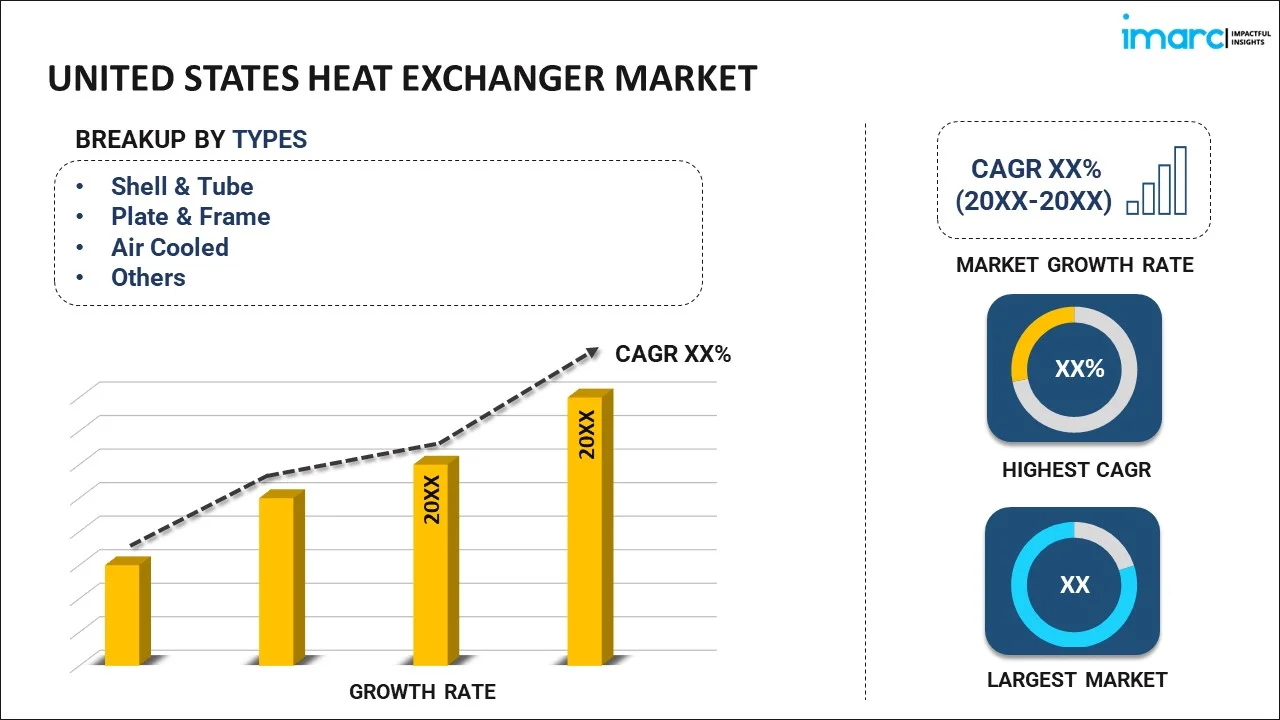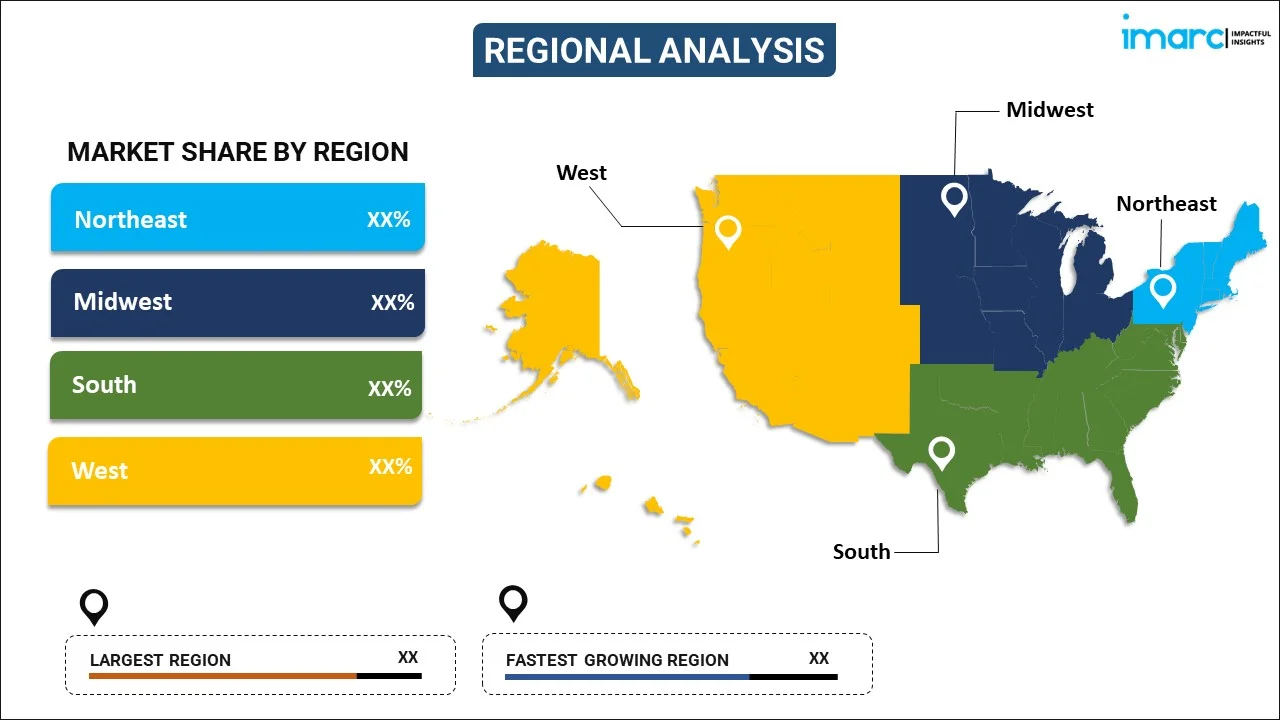
United States Heat Exchanger Market Report by Type (Shell & Tube, Plate & Frame, Air Cooled, and Others), Material (Carbon Steel, Stainless Steel, Nickel, and Others), End Use Industry (Chemical, Petrochemical and Oil & Gas, HVAC and Refrigeration, Food & Beverage, Power Generation, Paper & Pulp, and Others), and Region 2025-2033
United States Heat Exchanger Market Overview:
The United States heat exchanger market size reached USD 3.8 Billion in 2024. Looking forward, IMARC Group expects the market to reach USD 5.7 Billion by 2033, exhibiting a growth rate (CAGR) of 4.27% during 2025-2033. The market is driven by growing demand for energy-efficient solutions across industrial, commercial, and residential sectors. Stricter environmental regulations and decarbonization goals are pushing industries to adopt technologies that reduce emissions and optimize thermal processes. The modernization of HVAC systems, along with expansion in power generation, chemical processing, and food industries, is fueling the need for reliable heat transfer equipment. Additionally, rising awareness of sustainable practices encourages the integration of advanced, low-maintenance, and high-performance heat exchanger systems is surging the United States heat exchanger market share.
|
Report Attribute
|
Key Statistics
|
|---|---|
|
Base Year
|
2024
|
|
Forecast Years
|
2025-2033
|
|
Historical Years
|
2019-2024
|
|
Market Size in 2024
|
USD 3.8 Billion |
|
Market Forecast in 2033
|
USD 5.7 Billion |
| Market Growth Rate (2025-2033) | 4.27% |
United States Heat Exchanger Market Analysis:
- Major Market Drivers: Growing emphasis on energy efficiency and emission control fuels demand. Industrial process optimization and HVAC system upgrades push adoption. Regulatory support encourages investment in modern heat exchanger technologies.
- Market Key Trends: Shift toward compact, modular, and smart exchangers. Increased use of corrosion-resistant materials. Integration of Internet of Things (IoT) for predictive maintenance. Customization and design flexibility gaining priority across industries are some of the key United States heat exchanger market trends.
- Market Challenges: High initial costs and complex maintenance deter smaller firms. Raw material fluctuations impact margins. Technical design limitations and space constraints in retrofits challenge widespread implementation.
- Market Opportunities: Expanding renewable energy and waste heat recovery efforts offer growth avenues. Advances in materials and automation enhance product appeal. Sectoral diversification enables broader application across new industries in the United States heat exchanger market analysis.
Heat exchangers are devices utilized for transferring heat from one fluid to another and controlling the temperature of a substance or a system. These devices comprise streams of hot and cold liquids that are used to transfer thermal energy. As they enable the efficient functioning of machines and engines, they find extensive application in refrigerators, furnaces, sewage treatments, air conditioning systems, boilers and automotive radiators across the United States.
The United States represents one of the largest markets for heat exchangers. This can be accredited to the burgeoning oil and gas industry, along with the growing number of exploration and production (E&P) activities being undertaken in the country. Furthermore, the escalating demand for heat exchangers in industrial and commercial sectors is strengthening the growth of the market. Apart from this, heat exchangers also find application in chemical plants, which can be attributed to the varying temperature requirements of streams in different processes. Other factors fueling the market growth include the installation of superficial heat exchangers to upgrade the existing power units and minimize carbon emissions. However, the coronavirus disease (COVID-19) outbreak has disrupted manufacturing operations and impacted the supply chain across the country. This has negatively affected market growth, but once the vaccination is introduced and COVID-19 cases subside, the demand for heat exchangers will witness growth.
United States Heat Exchanger Market Trends:
Compact, Modular, and High-Efficiency Designs
The need for compact, energy-saving heat exchangers is expanding at a fast pace in a wide range of industries. Modular and compact designs make installation simpler and facilitate integration into new systems with limited real estate. Smaller sizes are particularly beneficial in retrofit applications and decentralized installations where efficiency and flexibility are essential. Modular designs also simplify maintenance and expansion, allowing users to add or replace modules without significant downtime. This trend is becoming more attractive in industries like HVAC, food processing, and manufacturing, where flexibility of operation and energy savings are critical. Manufacturers are working towards developing new shapes, flow patterns, and assembly techniques to address these changing demands, making heat exchangers highly customized while having high thermal performance and reliability across a wide range of applications.
Smart Heat Exchangers and Digital Integration
As businesses adopt automation and smart monitoring, heat exchangers are becoming increasingly intelligent devices with sensors and connectivity to data streams. These next-generation devices can monitor performance metrics like temperature, pressure, and fluid flow in real time, providing actionable information to maintenance personnel. Data-driven means predictive maintenance is possible, which reduces downtime and prevents damage beforehand. Incorporation into digital platforms and industrial control systems simplifies optimization of performance, particularly in large, complicated operations. Heat exchangers are no longer simply passive devices they are active players in energy optimization and system efficiency. As digital infrastructure becomes increasingly prevalent in industrial settings, the need for smart, networked heat exchangers grows, affecting design approaches and customer expectations for reliability, transparency, and management.
Use of Advanced and Corrosion-Resistant Materials
As demand increases for durability and longer equipment life, producers are employing advanced materials and coatings to resist corrosion and fouling. These materials are designed to perform under severe conditions like high temperatures, strong chemicals, or seawater environments. Their application is particularly common in marine, chemical processing, and food & beverage industries where system uptime is essential. In addition to improved base metals, internal surfaces are being coated with new coatings that improve efficiency of heat transfer and inhibit buildup to decrease the amount of cleaning and maintenance. This trend in material innovation enables heat exchangers to run for longer periods of time at a steady performance while reducing environmental wear and energy loss. The outcome is enhanced longevity, enhanced adherence to operational requirements, and minimized overall lifecycle costs to end users thereby contributing to the United States heat exchanger market growth.
United States Heat Exchanger Market Opportunities:
Growth in Waste Heat Recovery and Renewable Applications
The U.S. market for heat exchangers is expected to gain immensely from mounting investments in renewable technologies and energy recovery. Waste heat recovery technologies are becoming core to sustainability initiatives in manufacturing, power generation, and refining sectors. Heat exchangers play an important part in recovering waste heat from industrial processes and recycling it in order to enhance energy efficiency. Furthermore, the integration of heat exchangers with renewable energy technologies such as geothermal and solar thermal systems is opening up new opportunities for innovation and deployment. As companies set decarbonization and cost-saving goals for energy, customized solutions for heat exchangers are more sought after. This provides opportunities for those firms that can provide elastic, efficient, and sustainable products, particularly those in keeping with clean energy codes and forward-thinking industrial design.
United States Heat Exchanger Market Challenges:
Complex Maintenance and Operational Constraints
One of the biggest challenges to the United States heat exchanger market forecast is system maintenance complexity and long-term performance reliability. Most heat exchanger designs are prone to fouling, corrosion, and pressure drop, necessitating regular inspection, cleaning, or replacement. In applications where uptime is paramount, even slight inefficiencies can cause expensive shutdowns or decreased productivity. Further, the range of operating conditions—e.g., high temperature or harsh fluids requires advanced materials and designs, adding engineering and procurement complexity. In retrofit applications, limited space and system compatibility problems compound implementation difficulties. Skilled labor necessary to operate these advanced systems adds a further level of complexity, particularly as the workforce ages and technical talent becomes more difficult to obtain. These operational limitations tend to decelerate wider market uptake.
Key Market Segmentation:
IMARC Group provides an analysis of the key trends in each sub-segment of the United States heat exchanger market report, along with forecasts at the country level from 2025-2033. Our report has categorized the market based on type, material, and end use industry.
Breakup by Type:

To get more information on this market, Request Sample
- Shell & Tube
- Plate & Frame
- Air Cooled
- Others
Breakup by Material:
- Carbon Steel
- Stainless Steel
- Nickel
- Others
Breakup by End Use Industry:
- Chemical
- Petrochemical and Oil & Gas
- HVAC and Refrigeration
- Food & Beverage
- Power Generation
- Paper & Pulp
- Others
Breakup by Region:

- Northeast
- Midwest
- South
- West
Competitive Landscape:
The competitive landscape of the industry has also been examined along with the profiles of the key players.
Report Coverage:
| Report Features | Details |
|---|---|
| Base Year of the Analysis | 2024 |
| Historical Period | 2019-2024 |
| Forecast Period | 2025-2033 |
| Units | Billion USD |
| Segment Coverage | Type, Material, End Use Industry, Region |
| Region Covered | Northeast, Midwest, South, West |
| Customization Scope | 10% Free Customization |
| Post-Sale Analyst Support | 10-12 Weeks |
| Delivery Format | PDF and Excel through Email (We can also provide the editable version of the report in PPT/Word format on special request) |
Key Questions Answered in This Report
The United States heat exchanger market was valued at USD 3.8 Billion in 2024.
We expect the United States heat exchanger market to exhibit a CAGR of 4.27% during 2025-2033.
The extensive utilization of heat exchangers in boilers, furnaces, refrigerators, automotive radiators, sewage treatment, and air conditioning systems, is currently driving the United States heat exchanger market.
The sudden outbreak of the COVID-19 pandemic had led to the implementation of stringent lockdown regulations across the United States resulting in temporary closure of numerous manufacturing units of heat exchangers.
Based on the type, the United States heat exchanger market can be divided into shell & tube, plate & frame, air cooled, and others. Currently, shell & tube exhibits a clear dominance in the market.
Based on the material, the United States heat exchanger market has been bifurcated into carbon steel, stainless steel, nickel, and others. Among these, stainless steel holds the majority of the total market share.
Based on the end use industry, the United States heat exchanger market can be segmented into chemical, petrochemical and oil & gas, HVAC and refrigeration, food & beverage, power generation, paper & pulp, and others. Currently, the chemical industry represents the largest market share.
On a regional level, the market has been classified into Northeast, Midwest, South, and West, where South currently dominates the market.
Need more help?
- Speak to our experienced analysts for insights on the current market scenarios.
- Include additional segments and countries to customize the report as per your requirement.
- Gain an unparalleled competitive advantage in your domain by understanding how to utilize the report and positively impacting your operations and revenue.
- For further assistance, please connect with our analysts.
 Request Customization
Request Customization
 Speak to an Analyst
Speak to an Analyst
 Request Brochure
Request Brochure
 Inquire Before Buying
Inquire Before Buying




.webp)




.webp)












